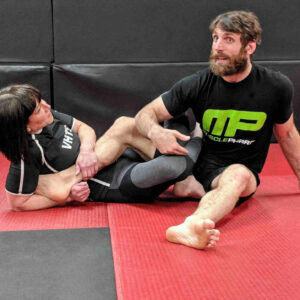
Afraid of heel hooks? Tapping too soon? Well, let’s work on fixing that once and for all. In essence, there are two ways of becoming good at defending heel hooks. The first is to become an experienced leg locker yourself, which will allow you to recognize and deflect attacks before they even happen. The other is to use a proven system of heel hook BJJ escapes developed by the original DDS leg lock master Eddie Cummings and never worry about tapping to leg locks again!
Understanding The BJJ Heel Hook
Where is the power of the heel hook coming from? Is it the twist of the heel? Is it the grips? Oh no, wait, it has to be the Ash Garami positions Danaher put together. While all of these help, none of them are directly responsible for the catastrophic damage the knee endures during heel hooks, particularly inside heel hook variations.
Similar to most things in Jiu-Jitsu, it is the hips that are responsible for the success of heel hooks. In fact, if you look at a heel hook similarly to how you look at an armbar or a kneebar, you’ll actually have a lot more success with it. Simply put, the “break” in the knee during a heel hook comes from projecting your hips to either side of the knee, depending on the variation you’re using.
Imagine you’re in a very tight Honeyhole position, heel hook grips wrapped up and everything in order. You can twist as much and eventually, you’ll get someone to tap out just before you feel like you’re at your end range of motion and your control is about to fall apart. What would happen if instead, you focused on getting the grip, twisting a bit, and then projecting your hips into the knee? A very efficient and very quick tap, that’s what.
Think about it this way. We talk about applying twisting motions to all straight submissions, like armbars, kneebars, and ankle locks. Why wouldn’t we apply straight pressure to twisting submissions to accentuate the pressure on the joint we are attacking? That’s precisely why heel hook BJJ attacks work so well, and exactly what you need to prevent/defend in order to escape them.
Heel Hook BJJ Escapes: Timing
When you’re looking to perfect heel hook BJJ escapes, your focus should be on remaining calm enough to know when to move and when to stay put. Timing is everything in leg lock defense and you can really mess up epically if you miss your window. And by mess up, I mean end up injuring yourself.
First things first – forget about trying to break their grips with your hands. No amount of grip fighting will get you out of a tight heel hook grip done from a solid Ashi Garami. Instead, think about what makes heel hooks strong and take it away from your opponent. before we go into the nuts and bolts of it, though, let’s talk about when you need to go for your heel hook escapes.
Your first checkpoint for escaping should be the moment you use someone going for an Ashi Garami. This is when you’re going to look for early ways out i.e. preventing the Ashi Garami from becoming a controlling position for your opponent.
The second checkpoint is when you’ve missed out on early defense, and now have to be content with getting out really really late. By late, I mean the moment they start applying breaking pressure. This is when you’ll use the power of heel hook mechanics against the submission, thus forcing a safe and reliable way out for yourself.
In both cases, you have chances to go immediately into counter leg locks once you’re safe. If you’re a leg locker yourself, that is.
Early Heel Hook Defense
Speaking of dealing with heel hooks BJJ attacks early, you should never let anyone grab a heel hook grip (or any leg locking finishing grip) from a solidified Ashi Garami position. Dealing with the Ashi Garami early is a lot easier than you might imagine – simply hold on to the knee of the leg under attack with the same side arm. Seriously, just hug your knee and watch as your partner effortlessly attempts to do any sort of leg lock.
The reasoning behind this type of defense is simple – no hip control means no breaking mechanics. Given that many people are too eager when they hunt leg locks and focus more on trying to grip a heel hook grip first and then find an Ashi Garami, this type of defense is extremely easy to set up and will annoy even seasoned leg lockers.
The only catch is that you need to time it right. The moment someone locks a tight Ashi around your hip, if your arm is not already threaded you won’t get a chance to do so and you should shift your attention to late-stage defense instead.
Eddie Cummings Approved Late Heel Hook Escapes
Back in the day when the Danaher Death Squad popularized heel hooks, Eddie Cummings was unbeatable in the department. He did not only fight a bunch of people who were thought to be leg lockers and submit them but never tapped himself. the secret to his success was understanding the mechanics of the Ashi Garami position and its relation to heel hooks.
The way the “Wolverine” approached heel hook BJJ escapes was to remove the knee of the leg under attack away from the opponent’s hips. There are a couple of very important things to know before you attempt this, though.
The first is that you actually need to wait for your opponent to establish a heel hook grip. Don’t worry, you’ll have time to get away, although not too much (after all, it is a late escape). The second is that you can’t just get the knee away from them in a simple motion.
Let’s analyze the position of your leg. Whether it is an inside or outside heel hook, your knee needs to be close to the opponent’s hips. If you draw an imaginary line from your ankle to your hip, your knee is not going to be on that line, but rather to one side of it. Your goal with late-stage heel hook BJJ defense – get it to the other side.
Simply trying to move the knee across this imaginary line will blow your knee out. However, if you get your butt near to your opponent and then shift (do a small hip escape) so that the leg under attack is not on the bottom, the knee will safely end up on the opposite side of the line. In other words, it’ll be very far away from the reach of the opponent’s hips, and you’ll be safe(ish).
In order to completely get away, you’ll need to straighten your foot (like a ballerina) and use a small land repeated see-saw motion to do a “heel slip”. The moment the heel is out of danger, you don’t have to actually escape the position. You can turn to your favorite heel hook BJJ counterattacks instead.
In Conclusion
Heel hook BJJ escapes do not have to be complicated. It does not take a different way to escape every heel hook variation out there. All you need is one battle-tested way to beat the most feared submission in BJJ history. And who better to learn from than the original modern heel hook master himself – Eddie Cummings?















































